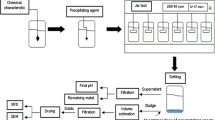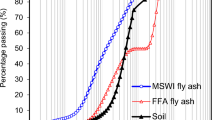Abstract
The objective of this study is to examine the solidification of toxic elements in tailings by the use of cement and blast furnace slag. Tailings samples were taken at an Au–Ag mine in Korea. To examine the best mixing ratio of tailings and the mixture of ordinary Portland cement (OPC) and blast furnace slag (SG) of 5:5, 6:6, 7:3, and 8:2, the 7:3 ratio of tailings and OPC+SG was adapted. In addition, the mixing ratios of water and OPC + SG were applied to 10, 20, and 30 wt%. After 7, 14, and 28 days’ curing, the UCS test was undertaken. A relatively high strength of solidified material (137.2 kg cm−2 in average of 3 samples) at 28 days’ curing was found in 20 wt% of water content (WC). This study also examined the leachability of arsenic and heavy metals (Cd, Cu, Pb, and Zn) under the Korean Standard Leaching Test, and it showed that the reductions in leachabilities of As and heavy metals of solidified samples were ranged from 76 to 99%. Thus, all the solidified samples were within the guidelines for special and hazardous waste materials by the Waste Management Act in Korea. In addition, the result of freeze–thaw cycle test of the materials indicated that the durability of the materials was sufficient. In conclusion, solidification using a 7:3 mixing ratio of tailings and a 1:1 mixture of OPC + SG with 20% of WC is one of the best methods for the remediation of arsenic and heavy metals in tailings and other contaminated materials.







Similar content being viewed by others
References
Adriano, D. C. (2001). Trace elements in the terrestrial environment-biogeochemistry, bioavailability, and risks of metals (2nd ed.). New York: Springer.
Alloway, B. J. (1995). Heavy metals in soils (2nd ed.). London: Blackie Academic & Professional.
Bayard, R., Chatain, V., Gachet, C., Troadec, A., & Gourdon, R. (2006). Mobilisation of arsenic from a mining soil in batch slurry experiments under bio-oxidative conditions. Water Research, 40, 1240–1248.
Bose, P., & Sharma, A. (2002). Role of iron in controlling speciation and mobilization of arsenic in subsurface environment. Water Research, 36, 4916–4926.
Choi, W. -H., Lee, S. -R., & Park, J. -Y. (2009). Cement based solidification/stabilization of arsenic-contaminated mine tailings. Waste Management, 29, 1766–1771.
Diet, J. N., Moszkowicz, P., & Sorrentino, D. (1998). Behavior of ordinary portland cement during the stabilization/solidification of synthetic heavy metal sludge: macroscopic and microscopic aspects. Waste Management, 18, 17–24.
Dutre, V., & Vandecasteele, C. (1998). Immobilization mechanism of arsenic in waste solidified using cement and lime. Environmental Science and Technology, 32, 2782–2787.
Jakubick, A., McKenna, G., & Robertson, A. M. (2003). Stabilisation of tailings deposits (pp. 1–9). Ontario, Canada: International Experience. Mining and the Environment III. Sudbury. 25-28 May.
Jang, A., & Kim, In. S. (2000). Solidification and stabilization of Pb, Zn, Cd and Cu in tailing wastes using cement and fly ash. Minerals Engineering, 13, 1659–1662.
Jung, M. C. (2001). Heavy metal contamination of soils and waters in and around the Imcheon Au-Ag mine, Korea. Applied Geochemistry, 16, 1369–1375.
Jung, M. C. (2008). Contamination by Cd, Cu, Pb, and Zn in mine wastes from abandoned metal mines classified as mineralization types in Korea. Environmental Geochemistry and Health, 30(2), 205–217.
Jung, M. C., & Thornton, I. (1996). Heavy metal contamination of soils and plants in the vicinity of a Pb-Zn mine, Korea. Applied Geochemistry, 11, 53–59.
Kim, S. O., Kim, W. S., & Kim, K. W. (2005). Evaluation of electrokinetic remediation of arsenic-contaminated soils. Environmental Geochemistry and Health, 27(4), 443–453.
Korean Ministry of Environment. (2006). Waste management act in Korea. Ministry of Environment. Seoul: KMOE.
Lasat, M. M. (2002). Phytoextraction of toxic metals: a review of biological mechanisms. Journal of Environmental Quality, 31, 109–120.
Lee, C. K., Chon, H. -T., & Jung, M. C. (2001). Heavy metal contamination in the vicinity of the Daduk Au-Ag-Pb-Zn mine in Korea. Applied Geochemistry, 16, 1377–1386.
Miller, J., Akhter, H., Cartledge, K., & McLearn, M. (2000). Treatment of arseniccontaminated soils II: treatability study and remediation. Journal of Environmental Engineering, 126, 1004–1012.
Moncur, M. C., Ptacek, C. J., Blowes, D. W., & Jambor, J. L. (2005). Release, transport and attenuation of metals from an old tailings impoundment. Applied Geochemistry, 20, 639–659.
Singh, T. S., & Pant, K. K. (2006). Solidification/stabilization of arsenic containing solid wastes using Portland cement, fly ash and polymeric materials. Journal of Hazardous Materials, 131, 29–36.
Ure, A. M. (1995). Methods of analysis for heavy metals in soils. In B. J. Alloway (Ed.), Heavy metals in soils, 2nd (2nd ed.). London: Blackie Academic and Professional.
Acknowledgments
This study was fully supported by a grant from the Mine Reclamation Corporation (MIRECO) in Korea.
Author information
Authors and Affiliations
Corresponding author
Rights and permissions
About this article
Cite this article
Kim, JW., Jung, M.C. Solidification of arsenic and heavy metal containing tailings using cement and blast furnace slag. Environ Geochem Health 33 (Suppl 1), 151–158 (2011). https://doi.org/10.1007/s10653-010-9354-2
Received:
Accepted:
Published:
Issue Date:
DOI: https://doi.org/10.1007/s10653-010-9354-2




